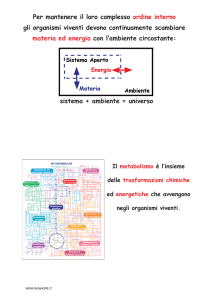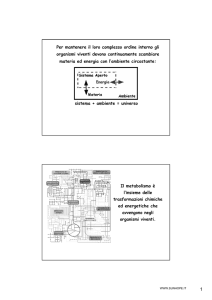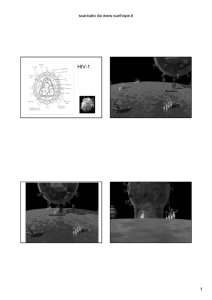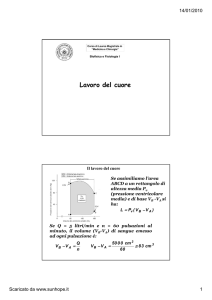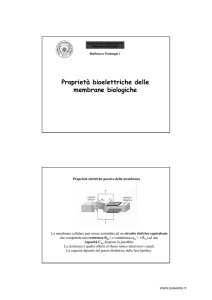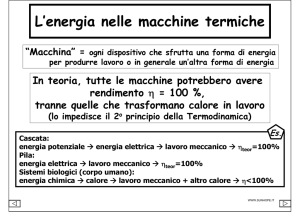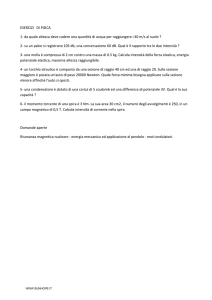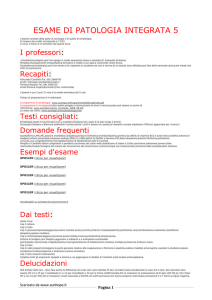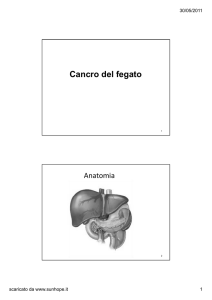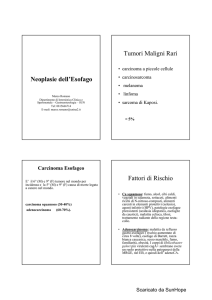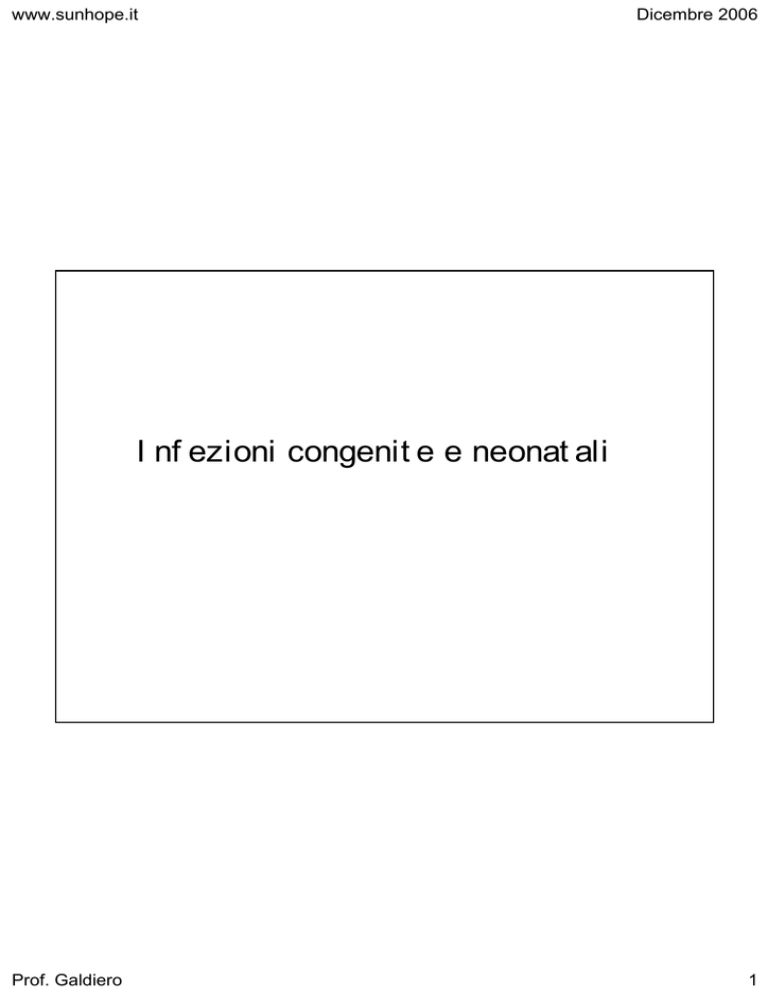
www.sunhope.it
Dicembre 2006
I nf ezioni congenit e e neonat ali
Prof. Galdiero
1
www.sunhope.it
Dicembre 2006
Donne in gravidanza
Perché maggior rischio:
Down- regulation dell’immunità
cellulare
Aumento del progesterone
Aumento della suscettibilità
ai patogeni intracellulari
Prof. Galdiero
2
www.sunhope.it
Dicembre 2006
Neonat i
Perché maggior rischio:
Sistema immunitario immaturo
Tendenza a sviluppare una
sintomatologia più severa
Completa dipendenza dalla
madre e da altri operatori
Prof. Galdiero
3
www.sunhope.it
Dicembre 2006
I nf ezioni congenit e e per inat ali
Prof. Galdiero
4
www.sunhope.it
Dicembre 2006
Vir us della Rosolia
Prof. Galdiero
5
www.sunhope.it
Dicembre 2006
Famiglia
Togavirus
Genere
Rubivirus genus
Virus
Virus della rosolia
Diversamente dalla maggior parte dei Togavirus
NON
è un virus trasmesso da artropodi
Trasmissione: via respiratoria
Prof. Galdiero
Struttura:
Virus con envelope
Capside icosaedrico
+ RNA virus, non-segmentato
Replicazione nel citoplasma
Esiste un solo tipo antigenico
6
www.sunhope.it
Dicembre 2006
Fotografia al microscopio elettronico di virus della rosolia
Rapidamente inattivato da agenti chimici, luce ultravioletta, basso pH, e calore
Nell’epoca pre-vaccinazione, 80% delle donne aveva già subito
l’infezione prima di raggiungere l’età riproduttiva
Prof. Galdiero
7
www.sunhope.it
Dicembre 2006
Dal momento dell’introduzione del
vaccino nel 1969, il numero di casi
di Rosolia è diminuito del 99%.
La rosolia è una forma febbrile
esantematica accompagnata da
linfoadenopatia malessere e
congiuntivite.
Il periodo di incubazione 14 gg
(range 12- 23 gg) (il 20- 50% delle
infezioni risultata asintomatica).
L’infezione è altamente trasmissibile al momento del rash cutaneo
anche se il virus può essere eliminato da 7 gg prima a 7 gg dopo
l’esantema.
Replicazione nel nasofaringe e nei linfonodi regionali.
Rash maculopapulare a 14- 17 gg.
Viremia dopo 5- 7 gg dall’infezione.
La placenta ed il feto possono essere infettati durante la viremia
Prof. Galdiero
8
www.sunhope.it
Dicembre 2006
Rosolia
Rash maculopapulare 14-17 gg
La distribuzione è come quella del morbillo, ma il colore delle lesioni è meno intenso
Prof. Galdiero
9
www.sunhope.it
Dicembre 2006
Rosolia criteri di classificazione
Caso clinico:
a) rash maculo-papulare
b) temperatura > 37.2
c) linfoadenopatia suboccipitale, post auricolare e
cervicale
d) congiuntivite
Caso sospetto: rash
•Diagnosi di laboratorio: presenza di IgM (4-5 giorni dopo il rash e
persistenti fino a 6 settimane) II campione
•Isolamento del virus (vie aeree respiratorio, sangue e urine) entro 4
giorni dal rash.
Prof. Galdiero
10
www.sunhope.it
Arthralgia or arthritis
adult female
children
Dicembre 2006
up to 70%
rare
Thrombocyt openic purpura
Encephalitis
1/3,000 cases
Neuritis
1/6,000 cases
Orchitis
rare
rare
Complicazioni sono estremamente rare (1 in 6000 casi). L’encefalopatia
da rosolia (cefalea, vomito, rigidità del collo, letargia, convulsioni)
possono aversi circa 6 gg dopo il rash cutaneo. Generalmente dura solo
pochi giorni e la maggior parte dei pazienti recupera completamente.
Nel caso sia mortale, il decesso si verifica dopo pochi giorni
dall’insorgere della sintomatologia.
Prof. Galdiero
11
www.sunhope.it
Dicembre 2006
Rosolia durante la gravidanza
I trimestre di gravidanza (può colpire tutti gli organi in formazione con
morte fetale e abnormalità congenite) Il 90% dei neonati colpiti durante
le prime 11 settimane di gestazione possono sviluppare Rosolia
congenita.
Nella fase tardiva della gestazione non si presentano manifestazioni
cliniche.
I neonati infetti eliminano il virus per circa 1 anno
Rosolia congenita: cecità (cataratta, retinopatia, glaucoma)
Sordità (degenerazione cocleare)
Microcefalia, ritardo mentale
Prof. Galdiero
12
www.sunhope.it
Dicembre 2006
Rischio di conseguenze in seguito ad infezione da
rosolia durante la gravidanza
Prima del concepimento
Rischio minimo.
0- 12 settimane
100% di rischio di infezione congenita
del feto seguita da maggiori anormalità
congenite. L’aborto spontaneo può
avvenire nel 20% dei casi.
13- 16 settimane
sordità e retinopatia nel 15%
dopo 16 settimane
sviluppo normale, leggero rischio di
retinopatia
Prof. Galdiero
13
www.sunhope.it
Dicembre 2006
Rubella - United States, 1966-2005
CRS
70000
80
60000
70
50000
60
50
40000
40
30000
30
20000
20
10000
10
CRS Cases
Rubella Cases
Rubella
0
0
1966 1970 1975 1980 1985 1990 1995 2000 2005
Year
Prof. Galdiero
14
www.sunhope.it
Dicembre 2006
Epidemia di Rosolia – Unit ed St at es,
1964-1965
• 12.5 milioni di casi
• 2,000 encefaliti
• 11,250 aborti
(chirurgici/spontanei)
• 2,100 decessi neonatali
• 20,000 casi di rosolia
congenita
– sordità - 11,600
– cecità - 3,580
– ritardo mentale - 1,800
Prof. Galdiero
15
www.sunhope.it
Dicembre 2006
Rosolia congenit a
•
•
•
•
•
•
•
Prof. Galdiero
Sordità
Cataratta
Difetti cardiaci
Microcefalia
Ritardo mentale
Alterazioni ossee
Danni epatici e splenici
16
www.sunhope.it
Dicembre 2006
Manifestazioni della rosolia congenita
%
80
70
60
50
40
30
20
10
0
Sordità
Prof. Galdiero
Cecità
CNS
Cuore
17
www.sunhope.it
Dicembre 2006
Bambino affetto da rosolia congenita
L’ispessimento della retina che porta alla cecità
Prof. Galdiero
18
www.sunhope.it
Dicembre 2006
Prevenzione della rosolia congenita
• Vaccinazione
• Evit ar e
l’esposizione
Prof. Galdiero
19
www.sunhope.it
Dicembre 2006
Vaccino
•
Composizione
Live virus (RA 27/3 strain)
•
Efficacia
95% (Range, 90%-97%)
•
Durata dell’immunità
A vita
•
Modalità di somministrazione
>1 Dose
•
Dovrebbe essere somministrato con il vaccino contro morbillo e
parotite (MMR) oppure morbillo, parotite e varicella ( MMRV)
Prof. Galdiero
20
www.sunhope.it
Dicembre 2006
I ndicazioni per la somminist razione del
vaccino MMR
•
Tutti i bambini >12 mesi d’età
•
Adolescenti suscettibili e adulti senza la documentazione di
evidenza all’immunità da rosolia
•
Particolare attenzione alle donne in età fertile
I mmunit à da rosolia
•
Documentazione di effettuata vaccinazione dopo il primo anno di
vita
•
Evidenza sierologica di immunità
•
Nascita prima del 1957 (escluso le donne in età fertile)
Prof. Galdiero
21
www.sunhope.it
Dicembre 2006
Cit omegalovir us
Prof. Galdiero
22
www.sunhope.it
Prof. Galdiero
Dicembre 2006
23
www.sunhope.it
Prof. Galdiero
Dicembre 2006
24
www.sunhope.it
Dicembre 2006
EPI DEMI OLOGI A del CMV
• Tr ansmissione or izont ale
• Tr ansmissione ver t icale
- I n ut er o
- Dur ant e il par t o
- Allat t ament o
Prof. Galdiero
25
www.sunhope.it
Dicembre 2006
Trasmissione
• Il CMV è trasmissibile al feto per via placentare
• Neonato= contatto con secrezioni materne infette
(allattamento al seno , canale del parto)
• Bambini=Urine o saliva di altri bambini infetti
• Adolesenti e adulti = Saliva, rapporti sessuali,
trasfusioni di sangue.
• Trapiantati= Trasfusioni di sangue,organi donati
(riattivazione dovuta alla immunosoppressione).
Prof. Galdiero
26
www.sunhope.it
Dicembre 2006
INFEZIONE MATERNA PRIMARIA
(quasi sempre asintomatica)
40% TRASMISSIONE
10-15 %
SINTOMATICI ALLA NASCITA
10%
NESSUN
ESITO
90%
SEQUENZE
TARDIVE
85-90 %
ASINTOMATICI ALLA NASCITA
5-15 %
SEQUENZE
TARDIVE
85-95 %
NESSUN ESITO
3/1000 NEONATI HANNO PROBLEMI CLINICI
LEGATI A CMV CONGENITO
Prof. Galdiero
27
www.sunhope.it
Dicembre 2006
I nf ezione Congenit a
• Definito come isolamento del CMV dalla saliva o
dalle urine entro tre settimane dalla nascita
• La più comune infezione congenita, colpisce 0.3 –
1% delle nascite. Rappresenta la seconda causa di
ritardo mentale dopo la Sindrome di Down.
• La trasmissione al feto può avvenire in seguito ad
infezione primaria della madre o riattivazione.
• Può essere trasmessa al feto durante tutto il
periodo della gestazione.
• Non c’è evidenza di teratogenicità, ma i danni sono
conseguenti alla distruzione delle cellule una volta
formate.
Prof. Galdiero
28
www.sunhope.it
Dicembre 2006
I nf ezione congenit a da CMV
• CNS - microcefalia, ritardo mentale, spasmo muscolare,
epilessia, calcificazioni periventriculari.
• Occhio - retinite e atrofia ottica
• Orecchio - sordità
• Fegato - epato-splenomegalia
• Polmoni - polmonite
• Coure - miocardite
• Porpora trombocitopenica, anemia
• Sequelae tardiva in individui asintomatici alla nascita
difetti dell’udito e ridotta capacità intellettiva
Prof. Galdiero
-
29
www.sunhope.it
Dicembre 2006
I nf ezione congenit a da CMV
Prof. Galdiero
30
www.sunhope.it
Dicembre 2006
I nf ezione congenit a da CMV
Prof. Galdiero
31
www.sunhope.it
Dicembre 2006
CMV
DIAGNOSI DI LABORATORIO
ADULTI IMMUNOCOMPETENTI
LATENTE: RICERCA lgG
INFEZIONE
ACUTA: RICERCA lgM
ISOL. VIRUS URINA
PTS IMMUNOCOMPROMESSI
MALATTIA DA CMV
QUANTIZZARE IL VIRUS
NEL SANGUE
DONNE IN GRAVIDANZA
INFEZIONE PRIMARIA: SIEROCONVERSIONE
lgM
lgG A BASSA AVIDITA’
NEONATI
INFEZIONE CONGENITA: ISOLAMENTO NEI PRIMI
10 GIORNI
Prof. Galdiero
32
www.sunhope.it
DI AGNOSI
di CMV
Dicembre 2006
• Cit ologia (Evidenza di
corpi di inclusione da
citomegalovirus da tessuti
infetti -rara)
• Sier ologia (Presenza di
CMV IgM dal sangue del
neonato)
• Colt ur a (Isolamento del
CMV dalle urine o dalla
saliva del neonato)
• PCR
• ECO
• Amniocent esi colt ur a vir ale e PCR
Prof. Galdiero
33
www.sunhope.it
Dicembre 2006
DIAGNOSI ECOGRAFICA di
INFEZIONE da CMV
Prof. Galdiero
34
www.sunhope.it
Dicembre 2006
Par vovir us
Prof. Galdiero
35
www.sunhope.it
Dicembre 2006
Par vovir idae
Acido nucleico
Simmetria del capside
Envelope
Struttura del genoma
Classificazione di Baltimore
Polimerasi virale
Diametro del virione (nm)
Dimensione del genoma (kb)
Prof. Galdiero
DNA
Icosaedrica
ss Lineare (+ 0 - )
II
18- 26
5
36
www.sunhope.it
Prof. Galdiero
Dicembre 2006
37
www.sunhope.it
Dicembre 2006
Par vovir idae
“Slapped-cheek” rash in bambini con il tipico eritema da “quinta malattia”.
Prof. Galdiero
38
www.sunhope.it
Dicembre 2006
I NFEZI ONE CONGENI TA da
PARVOVI RUS
• 50% delle donne in età fertile è
suscettibile all’infezione
• Il virus attraversa la placenta e
distrugge le cellule ematopoietiche
• Anemia fetale
• Gravi problemi cardiaci
• Il virus colpisce direttamente le cellule
del miocardio
Prof. Galdiero
39
www.sunhope.it
Dicembre 2006
Par vovir idae
Feto affeto da idrope fetale (aborto)
e placenta dopo infezione intrauterina da parvovirus B19
Prof. Galdiero
40
www.sunhope.it
Dicembre 2006
Par vovir idae
Prof. Galdiero
41
www.sunhope.it
Dicembre 2006
Par vovir idae
Prof. Galdiero
42
www.sunhope.it
Dicembre 2006
Diagnosi
Ricerca delle IgM
PCR
Prof. Galdiero
43
www.sunhope.it
Dicembre 2006
VARI CELLA-ZOSTER VI RUS
Prof. Galdiero
44
www.sunhope.it
Prof. Galdiero
Dicembre 2006
45
www.sunhope.it
Prof. Galdiero
Dicembre 2006
46
www.sunhope.it
Dicembre 2006
Diagnosi di laborat orio
Le manifestazioni cliniche della varicella o dello
zoster, sono così caratteristiche che raramente si
richiede la conferma in laboratorio. La diagnosi di
laboratorio può essere richiesta solo in caso di
manifestazioni atipiche, particolarmente nel caso di
pazienti immunocompromessi.
• Isolamento virale – raramente effettuato (richiede
2- 3 settimane)
• Identificazione diretta – osservazione al microscopio
elettronico del fluido delle vescicole (non può
distinguere tra HSV e VZV). Immunofluorescenza
• Sierologia – la presenza di VZV IgG è indicativa di
passata infezione ed immunità. La presenza di IgM
indica un’infezione primaria recente.
Prof. Galdiero
47
www.sunhope.it
Dicembre 2006
I NFEZI ONE CONGENI TA da
VARI CELLA
• Il 90% delle donne incinte è già immune, per
cui l’infezione primaria è molto rara
• L’infezione primaria durante la gravidanza
comporta maggiori rischi di complicazioni, in
particolare polmonite
• Le infezioni congenite sono rare
• Il rischio di danni al feto è < 2 % prima delle
20 settimane e quasi inesistente oltre.
Prof. Galdiero
48
www.sunhope.it
Dicembre 2006
I NFEZI ONE NEONATALE da
VARI CELLA
• Il neonato è vulnerabile quando il parto
avviene a pochi giorni dall’inizio della
sintomatologia nella madre
• Le manifestazioni dell’infezione:
– Lesioni cutanee disseminate
– Infezione viscerale
– Ipoplasia degli arti
– Polmonite
Prof. Galdiero
49
www.sunhope.it
Dicembre 2006
RI SCHI O MATERNO da
VARI CELLA
• Gli adulti (la madre) è a maggior rischio
rispetto al neonato di sviluppare
complicanze pericolose:
– Polmonite ( 20 %)
– Encefalite (1 %)
Prof. Galdiero
50
www.sunhope.it
Dicembre 2006
PREVENZI ONE della VARI CELLA
• Vaccinazione di bambini suscettibili ed
adulti (Vaccino vivo attenuato)
• Evitare l’esposizione durante la
gravidanza
• Immuno-globuline anti-Varicella-zoster
o chemioterapia con antivirali nel caso di
esposizione
Prof. Galdiero
51
www.sunhope.it
Dicembre 2006
Vaccino contro la Varicella
• Composizione
Virus vivo attenuato (Oka/Merck strain)
• Efficacia
95% (Range, 65%-100%)
• Durata dell’immunity
>7 anni
• Somministrazione
1 Dose
Può essere somministrato simultaneamente con il vaccino
trivalente contro il morbillo, parotite e rosolia
Prof. Galdiero
52
www.sunhope.it
Dicembre 2006
TOXOPLASMOSI
Prof. Galdiero
53
www.sunhope.it
Prof. Galdiero
Dicembre 2006
54
www.sunhope.it
Prof. Galdiero
Dicembre 2006
55
www.sunhope.it
Dicembre 2006
Agente Causale :
Toxoplasma gondii è un
protozoo che infetta la
maggior parte degli
animali a sangue caldo,
tra cui l’uomo.
Phylum:
Classe:
Sottoclasse:
Ordine:
Sottordine:
Famiglia:
Genere:
Specie:
Prof. Galdiero
Apicomplexa
Sporozoea
Coccidia
Eucoccidia
Eimeriina
Toxoplasmatidae
Toxoplasma
Toxoplasma gondii
56
www.sunhope.it
Prof. Galdiero
Dicembre 2006
57
www.sunhope.it
Dicembre 2006
I f elini sono l’unico ospit e def init ivo
conosciut o dove il T. condii può compier e
le f asi schizogonica e successivament e
gamogonica, e quindi il maggior reservoir
per l’infezione.
I gat t i si inf et t ano
nut r endosi di alt r i piccoli animali. I n
seguit o ad ingest ione di cisto o oocisti, i
par assit i invadono le cellule epit eliali del
piccolo int est ino dove vanno incont r o ad
un ciclo asessuat o seguit o da un ciclo
sessuale e f or mano delle oocisti che sono
poi r ilasciat e con le f eci. Le oocisti
rilasciate diventano infettive dopo 1-5 gg.
Le
oocisti
possono
sopr avviver e
nell’ambient e per diver si mesi e sono
r esist ent i
ai
disinf et t ant i,
al
congelament o e all’essiccament o, ma
possono esser e eliminat e a 70°C per 10
min.
Nell’uomo, i par assit i f or mano cist i nei
muscoli schelet r ici, nel miocar dio e nel
sist ema ner voso cent r ale, che possono
rimanere nell’ospite per tutta la vita.
Prof. Galdiero
58
www.sunhope.it
Dicembre 2006
Maiali ed altri
animali possono
ingerire terreno
contaminato
Feci del gatto
che
contaminano
con T. gondii il
terreno,
l’acqua e la
cassetta con
la segatura.
Consumare
carne cruda o
poco cotta
Giardinaggio
senza guanti
Consumo di
frutta e vegetali
non lavati
Bere acqua
contaminata
Prof. Galdiero
Una madre che contrae
l’infezione durante la
gravidanza può infettare il
feto per via
transplacentare
59
www.sunhope.it
Dicembre 2006
MANI FESTAZI ONI CLI NI CHE
della TOXOPLASMOSI
• La maggior parte delle infezioni sono
asintomatiche
• Quando i sintomi sono presenti, essi
sono simili alla mononucleosi
Prof. Galdiero
60
www.sunhope.it
Dicembre 2006
MANIFESTAZIONI di
TOXOPLASMOSI CONGENITA
•
•
•
•
•
Epat o-splenomegalia e I t t er o
Cor ior et init e
Danni al CNS
Convulsioni
Rit ar do ment ale
Prof. Galdiero
61
www.sunhope.it
Dicembre 2006
Diagnosi di laborat orio:
La diagnosi di toxoplasmosi può essere effettuata mediante:
- Osservazione del parassita
- Isolamento del parassita dal sangue o da altri fluidi biologici
mediante inoculazione intraperitoneale nel topo o in coltura.
I topi vengono testati per la presenza di toxoplasma nel
liquido peritoneale da 6 a 10 gg dopo l’inoculazione. Se non
viene ritrovato il parassita, i topi devono essere testati
sierologicamente da 4 a 6 settimane dopo l’inoculazione.
- Rilevamento del materiale genetico del parassita mediante PCR,
specialmente nelle infezioni congenite in utero
I test sierologici sono il metodo di scelta per la diagnosi, poiché le tecniche
precedenti sono tecnicamente complesse e lunghe.
Prof. Galdiero
62
www.sunhope.it
Dicembre 2006
DI AGNOSI di TOXOPLASMOSI
CONGENI TA
• Amniocent esi
- PCR
• Ecogr af ia
Prof. Galdiero
63
www.sunhope.it
Dicembre 2006
Toxoplasma gondii tachyzoites, stained with Giemsa, from a smear of
peritoneal fluid obtained from a mouse inoculated with T.
gondii. Tachyzoites are typically crescent shaped with a prominent,
centrally placed nucleus.
Prof. Galdiero
64
www.sunhope.it
Dicembre 2006
Cisti di Toxoplasma gondii in tessuto cerebrale
Prof. Galdiero
65
www.sunhope.it
Dicembre 2006
Toxoplasma- specific IgG per determinare
lo stato immunitario
Un t est IgM negat ivo esclude un’infezione
recent e, ma se posit ivo è di dif f icile
int erpret azione vist o che ant icorpi IgM
Toxoplasma- specifici
possono
essere
evidenziat i mediant e EI A f ino a 18 mesi
dall’infezione
Se la pazient e è incint a, e IgG/ IgM
posit iva, si deve ef f et t uare un t est di
avidità per le IgG
Un’alt a avidit à nei primi 12- 16 mesi di
gravidanza esclude un’inf ezione cont rat t a
durante la gestazione.
Una bassa avidit à non indica, invece, una
inf ezione recent e, vist o che alcuni individui
possono avere una persist ent e bassa avidit à
anche molt i mesi dopo l’inf ezione. Quindi
potenzialmente è
possibile
un’infezione
recente.
Prof. Galdiero
66
www.sunhope.it
Dicembre 2006
Formalin- fixed Toxoplasma gondii tachyzoites,
stained by immunofluorescence (IFA). This is
a positive reaction (tachyzoites + human
antibodies to Toxoplasma + FITC- labelled
antihuman IgG = fluorescence.)
Negative IFA for
antibodies to T. gondii.
Prof. Galdiero
67
www.sunhope.it
Dicembre 2006
Diagnosi ecografica di toxoplasmosi
Calcificazioni
Prof. Galdiero
68
www.sunhope.it
Dicembre 2006
Diagnosi ecografica di toxoplasmosi
Idrocefalo
Prof. Galdiero
69
www.sunhope.it
Dicembre 2006
Pr incipali I nf ezioni Congenit e :
conclusioni
• Rosolia Congenit a –
La chiave è la prevenzione mediante
vaccinazione universale
• I nf ezione congenit a da CMV –
La chiave è la prevenzione all’esposizione
durante la gravidanza
Prof. Galdiero
70
www.sunhope.it
Dicembre 2006
Pr incipali I nf ezioni Congenit e :
conclusioni
• I nf ezione congenit a da parvovirus –
Evitare l’esposizione è difficile
• I nf ezione congenit a da Varicella –
Il rischio del feto è minimo, ma alto per
la madre
Prof. Galdiero
71
www.sunhope.it
Dicembre 2006
Pr incipali I nf ezioni Congenit e :
conclusioni
• Toxoplasmosi congenit a –
La chiave è evitare l’esposizione durante
la gravidanza
Prof. Galdiero
72
www.sunhope.it
Dicembre 2006
Altre infezioni:
- HSV
- HIV
- Tr eponema pallidum
- List er ia monocyt ogenes
- Streptococchi gruppo B
- Chlamidia t r achomat is
- Neisser ia gonor r hoeae
- Escher ichia coli
- Clost r idium t et ani
- Stafilococchi
Prof. Galdiero
73
www.sunhope.it
Dicembre 2006
Her pes simplex
Prof. Galdiero
74
www.sunhope.it
Dicembre 2006
MALATTI A ERPETI CA PERI NATALE
• L’her pes genit ale f emminile può esser e r esponsabile di
infezione del neonato durante il parto.
• L’er pet e neonat ale è una condizione
estremamente rara (1 / 10000 feti nati vivi);
ser ia
ma
• Sebbene possa esser e
sost enut a da ent r ambi i
t ipi
di
vir us,
l’agente
etiologico è di solit o il
tipo 2;
Prof. Galdiero
75
www.sunhope.it
Dicembre 2006
• L’inf ezione cont r at t a dur ant e il passaggio at t r aver so il
canale da par t o è più f r equent e (90%) e può pr ovocar e
abor t o, mor t e f et ale i.u., fetopatia (lesioni ner vose,
viscerali, cutanee)
• St essi esit i per l’inf ezione f et ale per via transplacentare
(5%)
Prof. Galdiero
76
www.sunhope.it
Dicembre 2006
Diagnosi
• Esame microscopico diretto delle cellule
prelevate dalla lesione.
• Colt ura cellulare (HSV produce CPE ent ro
1- 3 giorni in cellule HeLa ,Hep2).
• I test sierologici sono utili solo per la
diagnosi di una inf ezione primaria da HSV,
non sono utili per la diagnosi di malattie
ricorrenti perché in genere queste non sono
accompagnate da un significativo aumento
del titolo anticorpale.
Prof. Galdiero
77
www.sunhope.it
Dicembre 2006
Poiché l’infezione perinatale da HSV rappresenta un
problema medico e sociale di notevole importanza è
indicato uno studio clinico-sierologico della popolazione
femminile in epoca preconcezionale.
• Donne senza ant icorpi ant i HSV
in gr avidanza sar à ef f et t uat o uno studio sierologico
una volt a al mese. Se la sier ologia r imane negat iva per
t ut t o l’ar co della gr avidanza non esist e alcun pr oblema.
Se invece dur ant e quest i cont r olli si assist e a una chiar a
sieroconversione, siamo in pr esenza di inf ezione
contratta in gravidanza con possibile fetopatia;
PARTO CESAREO INUTILE come misur a pr of ilat t ica
se l’infezione si trasmette per via transplacentare!
Prof. Galdiero
78
www.sunhope.it
Dicembre 2006
• Donne con anticorpi anti HSV
si eseguir à un monit or aggio sierologico in caso di
successiva gr avidanza allo scopo di evidenziar e event uali
recidive o reinfezioni.
La r ecidiva sar à svelat a da un aument o degli ant icor pi nel
t est FC ment r e il t est I F o ELI SA per le IgM specifiche
risulterà negativo;
La reinfezione risulterà car at t er izzat a anch’essa da un
aument o degli ant icor pi e posit iva al t est di I F e ELI SA
PARTO CESAREO (pr ima che si r ompano le membr ane o
ent r o le 4-6 h dalla r ot t ur a per pr eser var e il neonat o dal
contagio!)
Prof. Galdiero
79
www.sunhope.it
Dicembre 2006
Diagnosis
• I solament o del vir us in colt ur e cellular i
da campione pr elevat o da vescicole
cut anee, bocca, occhio, CSF. L’effetto
citopatico può esser e evidenziat o dopo
24-48 or e. I n alcuni casi di neonat i con
encef alit e, il vir us può esser e r it r ovat o
solo nel t essut o cer ebr ale mediant e PCR.
• Anche possibile neut r alizzazione, I F,
EM (con adeguat i MAbs)
Prof. Galdiero
80
www.sunhope.it
Dicembre 2006
Test di immunofluorescenza per gli antigeni
di HSV in cellule epiteliali
Effetto citopatico in cellule in coltura.
Notare l’effetto di arrotondamento delle cellule
Prof. Galdiero
81
www.sunhope.it
Dicembre 2006
HI V
Prof. Galdiero
82
www.sunhope.it
Dicembre 2006
RETROVIRIDAE
Acido nucleico
Simmetria del capside
Envelope
Struttura del genoma
Classificazione di Baltimore
Polimerasi virale
Diametro del virione (nm)
Dimensione del genoma (kb)
RNA
Icosaedrica
+
ss (+) copie
VI
+
80- 130
3,5- 9
MLV
(Murine Leukemia Virus)
Prof. Galdiero
83
www.sunhope.it
Dicembre 2006
AIDS (Acquired Immuno-Deficiency Syndrome)
1980/81- Segnalazione di focolai di polmonite da Pneumocystis carinii
associata a segni evidenti di compromissione del sistema immunitario
(immunodeficienza acquisita) in giovani adulti (per lo più maschi
omosessuali: “gay pneumonia”) e definizione “clinica” della
sindrome.
1983 - Isolamento in Francia (L. Montagnier) e in U.S.A. (R. Gallo) del
retrovirus oggi denominato HIV (human immunodeficiency virus )
ed inizialmente etichettato: LAV (Lymphoadenopathy associated
virus) o HTLV-III ( perché erroneamente ritenuto correlato ai
retrovirus oncogeni umani già noti: HTLV-I e HTLV-II).
1985 - Disponibilità dei primi reattivi (preparazioni di antigeni virali) per
la ricerca di anticorpi.
Prof. Galdiero
84
www.sunhope.it
Dicembre 2006
Progenie virale
Acquisizione del pericapside
Rna (+) genoma
Assemblaggio
Trascrittasi
inversa
Endonucleasi/
integrasi
Proteine
strutturali
Trascrizione
TAR
SpS
AAAA
RRE
Proteasi
Poliproteine
Traduzione
Traduzione
Proteine
Tat
regolatrici
Prof. Galdiero
Rev
85
www.sunhope.it
Dicembre 2006
HI V
Può causare:
• Parti pretermine.
• Scarso peso alla nascita.
• Ritardo mentale
• Anormalità craniofacciali
• Microcefalia.
• Infezione del feto.
Prof. Galdiero
86
www.sunhope.it
Prof. Galdiero
Dicembre 2006
87
www.sunhope.it
Prof. Galdiero
Dicembre 2006
88
www.sunhope.it
Prof. Galdiero
Dicembre 2006
89
www.sunhope.it
Dicembre 2006
La diagnosi di inf ezione da HI V
La ricerca di anticorpi nei confronti di HIV
Saggio immunoenzimatico
(Enzyme- linked Immuno- sorbent Assay o ELISA)
preparazioni di antigeni virali le cui caratteristiche consentano la
rilevazione di anticorpi nei confronti di HIV- 1 e HIV- 2 e per il
sottotipo O di HIV- 1
Prof. Galdiero
90
www.sunhope.it
Dicembre 2006
La diagnosi di infezione da HIV
•
Un risultato positivo all’ELISA va sottoposto ad esame "di conferma"
Immunoblotting
strisce con i diversi peptidi di HIV-1 e gp36 di HIV-2
Prof. Galdiero
91
www.sunhope.it
Dicembre 2006
La diagnosi di inf ezione da HI V
•
L’immunoblotting negativo o sicuramente positivo non lascia
dubbi interpretativi e non prevede ulteriori indagini
diagnostiche.
Prof. Galdiero
92
www.sunhope.it
Dicembre 2006
La diagnosi di inf ezione da HI V
Limiti della sierologia
•
1) fase iniziale (3- 4 settimane): la cosiddetta "finestra" iniziale
•
2) neonati di madri infette da HIV (anticorpi sierici materni)
•
3) in una modesta percentuale di soggetti: risultati "borderline”
Diagnostica Virologica: ricerca del virus.
Prof. Galdiero
93
www.sunhope.it
Dicembre 2006
Tr eponema pallidum
Prof. Galdiero
94
www.sunhope.it
Dicembre 2006
IL Treponema Pallidum,
appartiene alla famiglia delle
treponematacee, batteri di
forma elicoidale, mobili, a
divisione trasversale.
•
•
lunghezza variabile da 8 a 14 micron
larghezza variabile da 0.15 a 0.20 micron.
La coltura in vitro dei treponemi non è stata ancora
realizzata. Per tale motivo il loro metabolismo è poco
conosciuto.
Prof. Galdiero
95
www.sunhope.it
Dicembre 2006
ANATOMIA DEL TREPONEMA
STRUTTURA ANTIGENICA
Un antigene polisaccaridico
Un antigene lipidico
Un antigene proteico
Antigeni del corpo del
treponema
Prof. Galdiero
96
www.sunhope.it
Dicembre 2006
Sif ilide congenit a
La trasmissione materno-fetale può avvenire in
qualsiasi fase della malattia la madre si trovi, purchè
non trattata o inadeguatamente trattata.
Lo sviluppo placentare permette il passaggio di
T.pallidum in genere solo dopo la 16a settimana di
gestazione
Se contagio:
25%: morte in utero
25-30%: morte dopo la nascita
50%: sopravvivono ma manifestano segni di infezione nel
40-50%
Prof. Galdiero
97
www.sunhope.it
Dicembre 2006
Sif ilide congenit a: manif est azioni cliniche
1.
SI FI LI DE CONGENI TA PRECOCE: primi 2 anni di vit a
CUTE: infiltrati diffusi, placche, vescicole, papule, bolle,
rash desquamativo soprattutto palmo- plantare e peri- orale
MUCOSE: placche cavo orale, mucosa nasale faringea
OSSO: malformazioni (osteiti, osteoperiostiti soprattutto
delle ossa lunghe)
OCCHIO: iriti, corioretiniti, neurite ottica
FEGATO/RENE/SNC: focolai d’infiltrazione
2.
SIFILIDE CONGENITA TARDIVA:
Spesso si ha la sola positività sierologica, in assenza di segni
clinici
Manifestazioni oculari (cheratite interstiziale) o
osteoarticolari (malformazioni: naso “a sella”)
Anomalie dentarie (denti di Hutchinson o a semi- luna)
Anomalie acustiche: ipoacusia
Prof. Galdiero
98
www.sunhope.it
Dicembre 2006
Sif ilide: diagnosi
•
•
Prof. Galdiero
microscopia diretta in campo oscuro o
mediante immunofluorescenza diretta di
T.pallidum dalle lesioni in fase florida
Indagini sierologiche:
1) test non treponemici (VDRL)
ident if icano le I gM ed I gG r eaginiche che
compaiono durante la lue, cimentando il siero
del paziente con un antigene cardiolipinico.
2) test treponemici (FTA-abs e TPHA)
identificano le IgM ed IgG specifiche antiTreponema, cimentando il siero del paziente
direttamente con T.pallidum
99
www.sunhope.it
Dicembre 2006
Sif ilide: diagnosi
NON TREPONEMICI
•
•
•
TREPONEMICI
rischio di falsi positivi
• Più specifici ma più costosi
(virosi, connettiviti,
• Usati come test di
sarcoidosi) e falsi negativi
conferma ai test di
il titolo si riduce durante la
screening
malattia, tendendo a
negativizzarsi nelle fasi più
avanzate della stessa anche Diagnosi di lue congenita
in sogg. non trattati
1) Identificazione dell’antigene
usati come test di
treponemico mediante
screening o per monitorare
immunofluorescenza su campione
la risposta alla terapia
di aspirato rinofaringeo o cordone
ombelicale
2) Ricerca nel bimbo di IgM
specifiche anti-Treponema
Prof. Galdiero
100
www.sunhope.it
Dicembre 2006
GRAVI DANZA E SI FI LI DE CONGENI TA
SSi parla di sifilide congenita nel caso di trasmissione della malattia
durante la gravidanza al feto attraverso la placenta attraverso il contatto
con lesioni infette durante il passaggio nel canale del parto, oppure con
lesioni del capezzolo durante l’allattamento. L’infezione transplacentare
del feto può avvenire in qualunque fase dell’infezione materna e ad ogni
stadio della gravidanza
• L’infezione fetale è la regola in assenza di terapia nel caso di madre
affetta da lue primaria e/o secondaria
SScende al 40 % durante lo stadio di latenza precoce
• SScende al 6-14 % durante lo stadio latente tardivo
Prof. Galdiero
101
www.sunhope.it
Dicembre 2006
GRAVI DANZA E SI FI LI DE CONGENI TA
Le manifestazioni cliniche della lue perinatale assomigliano a quelle delle altre
infezioni che diffondono per via ematogena dalla madre al figlio
Il danno fetale dipende perciò dallo stadio di sviluppo al quale l’infezione
avviene, al tempo intercorso tra infezione e trattamento, all’adeguatezza
del trattamento, ad eventuali reinfezioni materne, alla risposta
immunitaria del feto.
Prof. Galdiero
102
www.sunhope.it
Dicembre 2006
GRAVI DANZA E SI FI LI DE CONGENI TA
La sifilide durante la gravidanza può
determinare:
• Aborto
• NNascita di un feto morto
• Parto prematuro
• Morte neonatale
• PParto a termine con neonati con infezione
clinicamente silente (da un terzo a metà dei
casi): spesso i neonati non presentano i
segni e i sintomi della malattia, che possono
comparire dopo mesi o anni oppure rimanere
silente per tutta la vita
• PParto a termine con neonati con infezione
clinicamente manifesta
Prof. Galdiero
103
www.sunhope.it
Dicembre 2006
SI FI LI DE CONGENI TA
A seconda che nel neonato l’infezione sifilitica si manifesti fin dalla nascita o tardivamente,
si distinguono rispettivamente la sifilide congenita precoce e la sifilide congenita
tardiva.
CLINICA DELLA SIFILIDE CONGENITA PRECOCE
DALLA NASCITA AI DUE ANNI D’ETA’
Prof. Galdiero
CLINICA DELLA SIFILIDE CONGENITA TARDIVA
DOPO I DUE ANNI D’ETA’
104
www.sunhope.it
Dicembre 2006
SI FI LI DE CONGENI TA TARDI VA
Perforazione del palato
Corioretinite
Retina normale
Prof. Galdiero
105
www.sunhope.it
Dicembre 2006
DIAGNOSI
1. Batteriologica
2.Sierologia
- Esami non treponemici
- Esami treponemici
Prof. Galdiero
106
www.sunhope.it
Dicembre 2006
DIAGNOSI DELLA SIFILIDE
% media di positività in relazione allo stadio di malattia
test
Prof. Galdiero
primario
secondario
latente
terziario
VDRL
78
100
95
71
FTA-Abs
84
100
100
96
TPHA
76
100
100
94
107
www.sunhope.it
Dicembre 2006
SCREENING
VDRL e TPHA sono i t est di scr eening per eccellenza
I test non treponemici utilizzati in combinazione con quelli treponemici
hanno un valore predittivo alto e i risultati positivi sono probabilmente
indicativi di un’ infezione reale
Prof. Galdiero
108
www.sunhope.it
Dicembre 2006
PREVENZI ONE DELLA SI FI LI DE CONGENI TA
Screening della sifilide congenita
Lo screening prenatale di routine, sia in aree ad alta che a bassa
incidenza, si raccomanda a tutte le donne durante la loro prima visita in
gravidanza. Nelle donne ad alto rischio i test sierologici dovrebbero
essere ripetuti durante il terzo trimestre e al momento del parto.
Vari studi hanno dimostrato che lo screening prenatale per la sifilide è
un metodo economicamente valido anche quando la prevalenza della
malattia tra le donne in gravidanza è solo dello 0.005 %. La sifilide
congenita attualmente si riscontra nello 0.05 % di tutti i nati vivi.
Prof. Galdiero
109
www.sunhope.it
Dicembre 2006
PREVENZI ONE DELLA SI FI LI DE CONGENI TA
La prevenzione della lue congenita
si attua mediante il controllo
sierologico in gravidanza e il
trattamento delle donne infette e
dei loro partners.
La sifilide congenita si può evitare
quindi praticando i test sierologici,
in quanto un adeguato trattamento
farmacologico effettuato alla
madre prima della fine del 4° mese
di gravidanza evita l’ infezione al
feto.
Prof. Galdiero
110
www.sunhope.it
Dicembre 2006
DIAGNOSI DELLA SIFILIDE CONGENITA
Per st abilir e se un neonat o da madr e por t at r ice dell’inf ezione non
adeguat ament e t r at t at a, sia ef f et t ivament e inf et t o le indicazioni
diagnostiche si basano:
• sulla ricerca delle IgM specifiche
• sulla evidenziazione dir et t a del micr or ganismo mediant e test di
immunofluorescenza su siero e liquido cefalorachidiano del neonato.
I neonat i di madr i sieroreattive devono esser e t r at t at i con penicillina,
indipendent ement e dal f at t o che la madr e f osse st at a o meno t r at tata
in gravidanza.
La sier onegat ivit à al par t o può non esser e un indice cer t o di noninf ezione mat er na. Quindi, in caso di madr e a r ischio per f at t or i
compor t ament ali o epidemiologici, bisogna ritestare la donna e il f iglio,
nei mesi successivi al par t o, specie qualor a il bambino pr esent i f ebbr e o
sintomi sospetti.
Prof. Galdiero
111
www.sunhope.it
Dicembre 2006
List er ia monocyt ogenes
Prof. Galdiero
112
www.sunhope.it
Dicembre 2006
Transplacental infection with Listeria
monocytogenes can result in fetal
dissemination with granuloma formation
(eg, in the liver, adrenal glands, lymphatic
tissue, lungs, and brain), called
granulomatosis infantiseptica. Aspiration
or swallowing of amniotic fluid or vaginal
secretions can lead to perinatal infection.
Nosocomial acquisition has been reported.
Prof. Galdiero
113
www.sunhope.it
Dicembre 2006
Infections in pregnant women may be asymptomatic or characterized
by a primary bacteremia presenting as a nonspecific flu-like illness.
In the fetus and newborn, clinical presentation depends on the
timing and route of infection. Abortion, premature delivery with
amnionitis (with a characteristic brown, murky amniotic fluid),
stillbirth, or neonatal sepsis commonly occurs. Infection may be
apparent within hours or days of birth, or it may be delayed up to
several weeks. Newborns with early-onset disease frequently are of
low birth weight, have associated obstetric complications, and show
evidence of sepsis with circulatory or respiratory insufficiency, or
both. Those with the delayed-onset form are full-term, previously
well newborns presenting with meningitis or sepsis.
Neonatal mortality, from 10 to 50%, is higher in infants with early-onset
disease.
Prof. Galdiero
114
www.sunhope.it
Dicembre 2006
Diagnosis and Prognosis
• The organism can be cultured from umbilical cord or peripheral
blood vessels; the newborn's CSF, gastric aspirate, and meconium;
the mother's lochia and exudates from cervix and vagina; and
grossly diseased parts of the placenta.
• Blood and cervix specimens should be obtained from any pregnant
woman with a febrile disease and cultured for L. monocytogenes. A
sick newborn born to a mother with listeriosis should be evaluated
for sepsis (see above). CSF examination may show a predominance
of mononuclear cells. Gram-stained smears frequently are negative
but may show pleomorphic, gram-variable coccobacillary forms,
which should not be disregarded as diphtheroid contaminants.
Serologic tests are not useful.
Prof. Galdiero
115
www.sunhope.it
Dicembre 2006
Treatment
Initial treatment with ampicillin plus an aminoglycoside is
preferred. Synergy of ampicillin or penicillin with an
aminoglycoside or rifampin has been demonstrated, and
trimethoprim-sulfamethoxazole and imipenem are active
against L. monocytogenes; however, these regimens
have not been well evaluated in the newborn. After
clinical response is observed, ampicillin alone may be
given. A 14-day course is usually satisfactory, but the
optimal duration is unknown. Other adjuncts should also
be given to the newborn with sepsis (see Neonatal
Sepsis, above). Drainage/secretion precautions should
be considered for heavily infected infants.
Prof. Galdiero
116
www.sunhope.it
Dicembre 2006
LISTERIA MONOCYTOGENES
•
Gram positive coccobacilli, readily
decolorized; mistaken for gram negatives,
diphtheroids, etc.
•
Maternal infection- cheese, milk, shellfish,
uncooked vegetables fertilized with sheep
manure
•
•
Prof. Galdiero
Pathogenic strains are Ia , Ib, IV b
May cause recurrent abortions
117
www.sunhope.it
Dicembre 2006
LISTERIA MONOCYTOGENES
•
EARLY ONSET DISEASE:
Flu like symptoms in mother
Diminished fetal movements
Fetal distress, chorio, meconium
staining
Respiratory distress, fever,
Disseminated infection
•
LATE ONSET DISEASE: MEAN AGE 14
DAY
Meningitis due to IVb most common
Prof. Galdiero
118
www.sunhope.it
Dicembre 2006
List er ia monocyt ogenes
Listeriosis
(invasive disease & non-invasive
enteritis)
•
The organism – G+ve ovoid to
rod-shaped bacterium
•
Prof. Galdiero
Widespread in environment
119
www.sunhope.it
Dicembre 2006
List er ia monocyt ogenes
• Char act er ist ics
- grows in wide range of
temperatures (1 to 45o C)
- survives freezing
- aerobic & anaerobic
conditions
Prof. Galdiero
120
www.sunhope.it
Dicembre 2006
List er ia monocyt ogenes
• CCP’s & hur dles
- higher temperatures, low pH, a
number of preservatives
- disinfectants (alcohols, phenols &
QAC’s)
- UV radiation
Prof. Galdiero
121
www.sunhope.it
Dicembre 2006
List er ia monocyt ogenes
Pathogenesis
- bacterium crosses
intestinal epithelial
cells & M cells in Peyer’s
patches via phagosomes
- released into cytoplasm &
multiplies
- invades next cell,
propelled by actin tail
- phagosomes transported
via blood vessels to
lymph nodes, liver,
spleen, brain & placenta
Prof. Galdiero
122
www.sunhope.it
Dicembre 2006
List er ia monocyt ogenes
• The illness – invasive f or m
- incubation – 30 days
- flu’-like sympt oms, diar r hoea,
vomiting, meningitis, septicaemia,
spontaneous abortion
Prof. Galdiero
123
www.sunhope.it
Dicembre 2006
List er ia monocyt ogenes
• The illness – invasive
f or m, cont inued
- infective dose – 100 to 1 000
cells
- pregnant women, newborn
babies, t he elder ly & AI DS
patients
- Rx – penicillin, ampicillin +/gentamicin
Prof. Galdiero
124
www.sunhope.it
Dicembre 2006
List er ia monocyt ogenes
• The illness – non-invasive
- incubation – 18 hours
- diar r hoea, f ever , muscle pain,
headache, abdominal cr amps &
vomiting
Prof. Galdiero
125
www.sunhope.it
Dicembre 2006
List er ia monocyt ogenes
• The illness – non-invasive
- infective dose – > 100 t hou. cells/ gm
- all individuals susceptible
- Rx - penicillin, ampicillin +/gentamicin
Prof. Galdiero
126
www.sunhope.it
Dicembre 2006
List er ia monocyt ogenes
•
Sources
- human – person-to-person rare
- animal – diseased animals shed in faeces,
contamination of red meat; silage
- food – ready-to-eat cooked food with long
shelf-life
-
raw foods
- environment – widespread in soil, water & sewage
(Hospitals & occupational exposure)
Prof. Galdiero
127
www.sunhope.it
Dicembre 2006
List er ia monocyt ogenes
•
Out br eaks/ incident s
NZ:
– unpasteurized milk, uncooked hotdogs,
undercooked chicken, soft cheeses,
delicatessen counter foods
Prof. Galdiero
128
www.sunhope.it
Dicembre 2006
List er ia monocyt ogenes
2004
2002
2000
1998
1996
1994
1992
1990
1988
1986
1984
1982
40
35
30
25
20
15
10
5
0
1980
Number of cases
Listeriosis cases in NZ from 1980 to 2004
Year
Prof. Galdiero
129
www.sunhope.it
Dicembre 2006
List er ia monocyt ogenes
• Out br eaks/ incident s
Over seas:
– invasive – coleslaw, Mexican-style
f r esh cheese, por k t ongue
- non- invasive – corn salad, cold
smoked trout,
chocolate milk
Prof. Galdiero
130
www.sunhope.it
Dicembre 2006
St r ept ococchi gr uppo B
Prof. Galdiero
131
www.sunhope.it
Dicembre 2006
GBS - TRANSMISSION
GBS colonized
mother
1 in 4 women
50%
50%
Non- colonized
newborn
Colonized
newborn
98%
Asymptomatic
Prof. Galdiero
2
% sepsis,
Early- onset
pneumonia,
meningitis
132
www.sunhope.it
Dicembre 2006
MATERNAL GBS COLONI ZATI ON
• Maj or r isk f act or f or neonat al inf ect ion
• Best pr edict ed by cult ur e of bot h vagina
and rectum late in pregnancy.
• Bact er iur ia = heavy colonizat ion = higher
risk
• Ver t ical t r ansmission occur s af t er t he
onset of labor or membr ane r upt ur e.
Prof. Galdiero
133
www.sunhope.it
Dicembre 2006
TIMING RECTO-VAGINAL
CULTURE
• Culture at 35-37 weeks
• Culture-delivery interval:
<6wks >6
wks
• Pos Predictive Value
• Neg Predictive Value
Prof. Galdiero
89%
97%
67%
91%
134
www.sunhope.it
Dicembre 2006
RI SK VS. SCREENI NG- BASED
APPROACH
• The 2 st r at egies wer e compar ed in inf ant s bor n in 98
and 99
• Only 52% of deliver ies had pr enat al GBS scr eening
• The scr eening appr oach was > 50% mor e ef f ect ive
than the risk based approach
• Screening captured colonized women without risk
factors (18% of all deliveries)
• Among women who did not receive IAP, infection was
1.3/1000 LB; 0verall infection rate was 0.5/ 1000lB
Schrag et al, NEJM 2002, 347:233-9
Prof. Galdiero
135
www.sunhope.it
Dicembre 2006
FACTORS ASSOCI ATED WI TH EO GBS
multivariable analysis
RR (95% CI)
GBS screening
0.46 (0.36-0.60)
Prolonged ROM (> 18
h)
Pre-term delivery
Black race
Maternal age <20 y
Previous GBS infant
1.41 (0.97-2.06)
1.50 (1.07-2.10)
1.87 (1.45-2.43)
2.22 (1.59-3.11)
5.54 (1.71-17.94)
Intrapartum fever
5.36 (3.60-7.99)
Schrag et al, NEJM 2002, 347:233-9
Prof. Galdiero
136
www.sunhope.it
Dicembre 2006
The 2002 GBS Prevention
Recommendations
Prof. Galdiero
137
www.sunhope.it
Dicembre 2006
RECOMMENDATI ONS
•
Single strategy - culture based
•
Second line agents for IAP
•
Management of planned cesarean deliveries
•
Management of threatened preterm deliveries
•
Detail on specimen collection and handling
•
Neonatal management
Prof. Galdiero
138
www.sunhope.it
Dicembre 2006
SINGLE STRATEGY –
CULTURE BASED
• All pregnant women screened at 35-37
weeks
• Vaginal and rectal GBS colonization
• IAP should be provided to all identified
carriers
• All women with GBS bacteruria receive
IAP;
no need for RV culture at 35-37 wks
Prof. Galdiero
139
www.sunhope.it
Dicembre 2006
I AP I NDI CATI ONS
with new universal prenatal screening guidelines
• Pr evious inf ant wit h invasive GBS disease
• GBS bact er iur ia dur ing cur r ent pr egnancy
• Posit ive GBS scr eening cult ur e dur ing cur r ent
pregnancy (unless a planned cesarean
delivery,
in t he absence of labor or ROM)
• Unknown GBS status & any of the foll:
Delivery at <37 weeks’
ROM 18 hours
Intrapartum
temperature 100.4°F (
38.0
°C)
Prof. Galdiero
140
www.sunhope.it
Dicembre 2006
I AP NOT I NDI CATED
• Planned cesar ean deliver y per f or med in t he
absence of labor or membrane rupture
(r egar dless of mat er nal GBS cult ur e st at us)
• Negat ive vaginal and r ect al GBS scr eening
culture during the current pregnancy,
regardless of intrapartum risk factors
• Pr evious pr egnancy wit h a posit ive GBS
scr eening cult ur e, unless a cult ur e was ALSO
positive during the current pregnancy
Prof. Galdiero
141
www.sunhope.it
Dicembre 2006
PLANNED CESAREAN
DELIVERIES
Ret r ospect ive, single hospit al st udy
IAP not routinely recommended
I n t he absence of labor / ROM, r isk ver y low
Prenatal screening recommended as labor or
ROM might occur bef or e scheduled sur ger y
In rare cases – if pt or MD opts for Rx –
Rx at incision r at her t han 4 hr s PTD may be
reasonable
Prof. Galdiero
142
www.sunhope.it
Dicembre 2006
THREATENED PRETERM
DELI VERY
Labor or ROM at <37 wks’ gestation
• Culture and start IV antibiotics
• Cult ur e negat ive: st op ant ibiot ics at 48 hr s
• Cult ur e posit ive: ant ibiot ics f or at least 48
hrs during tocolysis; no data on duration of
antibiotics before active labor.
When act ive labor begins give I AP
• Cult ur e negat ive and undeliver ed wit hin 4 wks:
re-screen
Prof. Galdiero
143
www.sunhope.it
Dicembre 2006
THREATENED PRETERM
DELIVERY
Labor or ROM at <37 wks’ gest
• If a negative culture in last 4 weeks is on
record, or if the clinician determines that labor
can be successfully arrested and preterm
delivery averted – antibiotics should not be
initiated
• Antibiotics during pregnancy may be
associated with NEC, need for supplemental
oxygen; antibiotics should only be given if
significant risk of delivery is present
Prof. Galdiero
144
www.sunhope.it
Dicembre 2006
ADVERSE EFFECTS – IAP
• Potential for serious penicillin reaction
(fatal anaphylaxis = 1:100,000)
• Possible emergence of antibiotic resistant
bacteria
• GBS resistance to Pen - not reported to
date
• GBS resistance to Clindamycin &
Prof. Galdiero
145
www.sunhope.it
Dicembre 2006
CDC RECOMMENDED IAP
MMWR, 2002
• DOC: Penicillin G; alternative – Ampicillin
• Penicillin allergic women:
– Not at hi-risk for anaphylaxis: Cefazolin
– At hi-risk for anaphylaxis:
• GBS susceptible: Clindamycin or erythromycin
• GBS resistant to above: Vancomycin
Prof. Galdiero
146
www.sunhope.it
Dicembre 2006
PENICILLIN ALLERGY
• Among pen-allergic women - if hi-risk for
anaphylaxis, cefazolin is the IAP agent of
choice.
• Cefazolin better: achieves effective AF
concentrations, has a narrow spectrum of
activity
• GBS resistance to Cefoxitin (second gen)
reported
• Verification of history of allergy is important
Prof. Galdiero
147
www.sunhope.it
Dicembre 2006
SUSCEPTIBILITY OF GBS: 19952000
• 1280 isolates
• All susceptible to penicillin, ampicillin,
cefozolin and vancomycin
– 19% erythromycin resistance
– 11% clindamycin resistance
– Rx failures due to increasing resistance
among GBS to erythromycin and clindamycin
Prof. Galdiero
148
www.sunhope.it
Dicembre 2006
Early-Onset E. coli Infections
first reported at CCH – Chicago
18
20
15
12
12
10
5
3
0
1982-87
1988-93
Overall Amp-Resistant
Joseph, T, Pyati SP, Jacobs, N: Neonatal Early-Onset Escherichia coli Disease: The Effect of
Intrapartum Ampicillin
Arch Pediatr Adolesc Med.1998; 152:35-40
Prof. Galdiero
149
www.sunhope.it
Dicembre 2006
HI-RISK FOR ANAPHYLAXIS
• H/O immediate reaction to penicillin
– anaphylaxis, angioedema, urticaria,
etc
• H/O asthma/diseases - anaphylaxis
difficult to Rx
• Patients receiving beta-adrenergic
blockers
• 10% have allergies to cephalosporins
• Vancomycin should be reserved for
Prof. Galdiero
150
www.sunhope.it
Dicembre 2006
FUTURE PREVENTION
TECHNOLOGY
• Rapid testing –
fluorogenic PCR assay - 45 min,
97% sensitive, 100% specific
wait FDA release
• GBS vaccines
promises, promises
Prof. Galdiero
151
www.sunhope.it
Dicembre 2006
EOGBS AND CFR
BASED ON GESTATIONAL AGE
EOGBS
Case
# (%)
Fatality
Age
< 33 wk
137 (9)
%
30
34-36 wk
116 (7)
10
1,247 (83)
2
Gestational
>37 wk
Schrag, New Engl J Med 2000 342: 15-20
Prof. Galdiero
152
www.sunhope.it
Dicembre 2006
NEONATAL MANAGEMENT
• Maternal chorioamnionitis: full diagnostic
evaluation & empiric broad-spectrum
antibiotic coverage pending blood culture
result
• LP if clinical signs of sepsis (if feasible)
• Consensus on adequacy of 4 hr IAP
(as opposed to 2 doses)( if pen, amp,
Prof. Galdiero
153
www.sunhope.it
Dicembre 2006
TIMING OF IAP IMPORTANT
ampicillin to
delivery
NO ampicillin
< 1hr
1- 2 hr
Maternal
Neonatal
Colonizatio Colonization #
n#
(%)
253
120
(47)
24
11 (46)
21
6 (28)
2-4 hr
70
2 (3)
>4hr
86
1 (1)
De Cuenta Ob. Gy 1998
Prof. Galdiero
154
www.sunhope.it
Dicembre 2006
24 HOUR DISCHARGE
1996:
2002:
No 24-hr discharge may discharge after 24
!
hr, if:
asymptomatic,
4 hrs IAP,
38 wks’
adequate home
observation
Prof. Galdiero
155
www.sunhope.it
Dicembre 2006
Chlamidia t r achomat is
Prof. Galdiero
156
www.sunhope.it
Dicembre 2006
CHLAMYDIA
• Most prevalent STD in the US today
• Most common cause - ophthalmia
neonatorum
• Prevalence in pregnant women 6% - 12%
high in adolescents, reinfection frequent
• Perinatal transmission = 50% (Vaginal Del)
In CS with PROM
• If mother has active, untreated infection
Conjunctivitis = 25 - 50 %
Pneumonia
= 10 - 20 %
Prof. Galdiero
157
www.sunhope.it
Dicembre 2006
OTHER CHLAMYDIA
INFECTIONS
• Infants born to Chlamydia + mothers may
develop asymptomatic infection of the
rectum/ urogenital tract
• Such infection may persist for up to 3
years
• Differentiating perinatal infection from
infection sec. to sexual abuse is difficult in
young children
Prof. Galdiero
158
www.sunhope.it
Dicembre 2006
LIFE CYCLE OF
CHLAMYDIAE
• Following infection, the infectious
elementary bodies EBs, enter the host cell
by endocytosis
• The EBs differentiate into Reticulate
Bodies (reproductive form) that undergo
binary fission
• The RBs differentiate back into EBs and at
about 48 hours, are released from the host
cell
• Unlike other bacteria, the life cycle of
Prof. Galdiero
159
www.sunhope.it
Dicembre 2006
PERINATALLY ACQUIRED C
trachomatis
Neonatal infection has markedly decreased
in the last decade, as:
• Highly sensitive and specific nucleic acid
amplification tests (NAATs) are now
available
• Systematic screening and Rx in pregnant
women
Prof. Galdiero
160
www.sunhope.it
Dicembre 2006
CHLAMYDIA CONJUNCTIVITIS
•
•
Onset: 5-14 d (< 30d), earlier if PROM
Ocular congestion, tarsal edema lasts 1-2
weeks
•
Initially watery eye discharge – later
purulent
•
•
Friable conjunctiva
Untreated - chemosis &
psuedomembranous conjunctivitis can
Prof. Galdiero
161
www.sunhope.it
Dicembre 2006
CHLAMYDIA PNEUMONIA
•
•
•
•
•
50% have history of conjunctivitis
•
•
May have nasal stuffiness and otitis
Onset 3 -20 wk, afebrile, moderately ill
Repetitive staccato cough
Tachypnea, rales present, no wheezing
Very young infants - apnea, respiratory
failure
X-ray - hyperinflation, bilateral diffuse
infiltrates
•
Prof. Galdiero
162
www.sunhope.it
Dicembre 2006
CHLAMYDIA - DIAGNOSIS
•
Direct antigen tests: PCR, LCR etc.
(false positives - not for abuse Dx)
•
Indirect evidence: eosinophilia > 400
cells/L;
elevated IgG, IgM; C-specific IgM, etc
•
Definitive: isolation of organism (tissue
culture)
•
Geimsa – blue, large inclusions in
epithelial cells
Prof. Galdiero
163
www.sunhope.it
Dicembre 2006
CHLAMYDIA - TREATMENT
•
DOC - PO erythomycin - 14 d- 50mg/kg/day
- 4 divided doses
Efficacy = 80%; may need second course
•
Assn with IHPS in infants < 6wk;
report to MEDWATCH, Inform parents of
risk
•
PO sulfonamides after the early neonatal
period
for infants who do not tolerate erythromycin
•
Topical Rx ineffective; also, fails to
eliminate nasopharyngeal carriage
Prof. Galdiero
164
www.sunhope.it
Dicembre 2006
CHLAMYDIA - PREVENTION
•
MOTHER:
–Screen 1st, 3rd trimester (& partners)
–Rx mothers/partners: amoxicillin /
erythromycin
or single dose azithromycin; not doxycycline
•
INFANT:
–No effective topical prophylaxis at birth
–Newborns of untreated mothers: At hi risk!
Prof. Galdiero
165
www.sunhope.it
Dicembre 2006
Neisser ia gonor r hoeae
Prof. Galdiero
166
www.sunhope.it
Dicembre 2006
NEISSERIA GONORRHOEA
• Etiology: Gram-negative diplococcus
Intra-cellular, within neutrophils in the
purulent discharge
• Epidemiology: Infection occurs only in
humans
Prevalence in mothers 1-2 %
Most common in neonate – opth
neonatorum
• Co-infection with Chlamydia in 15% - 20%;
and with other STDs
Prof. Galdiero
167
www.sunhope.it
Dicembre 2006
GC - DIAGNOSIS
• Isolation of organism - definitive
Thayer Martin/ Chocolate Agar medium
CO2 enriched incubator; Transport systems
• Gram-Stain: gram-neg. intracellular
diplococcus
DNA amplification methods ?
• Antibiotic susceptibility testing:
Penicillinase Producing NG - PPNG
Plasmid-mediated high level tetracycline
Prof. Galdiero
168
www.sunhope.it
Dicembre 2006
GC CONJUNCTIVITIS - OCULAR
EMERGENCY
• Conjunctivitis:
Onset - 2-7 days; maybe on day 1
hyperacute, purulent, very swollen
eye
Untreated_ corneal ulceration,
corneal perforation, iridocyclitis,and
blindness
Infants <4 wks of age with
conjunctivitis STAT gram stain – hi
index of suspicion
• Uncommon Manifestations:
Prof. Galdiero
169
www.sunhope.it
Dicembre 2006
GC - TREATMENT
• Hospitalize, standard contact isolation
• Cefotaxime X1 dose - 100mg/kg – IV /
IM;
if no risk of jaundice, Ceftriaxone X1 dose
• Irrigate eyes saline until no discharge
with or without topical antibiotics
• Eye consult
• Sepsis- Rx 10 d; Meningitis– Rx 14 d
Prof. Galdiero
170
www.sunhope.it
Dicembre 2006
GC - PREVENTION
• Prophylaxis: 1% silver nitrate; 1%
tetracycline;
0.5% erythromycin eye ointment.
Ineffective for Chlamydia.
Crede may be delayed for 1 hr
• Untreated maternal GC at delivery:
Cefotaxime: 1 dose;
or Ceftriaxone – 1dose; lower dose for
premies
• Routine endocervical culture screening:
Prof. Galdiero
171
www.sunhope.it
Dicembre 2006
Escher ichia coli
Prof. Galdiero
172
www.sunhope.it
Dicembre 2006
Bacterial virulence
Host defence
Behavioral/biological factor
1. Bacterial virulence
•
•
Mainly Escherichia coli
Almost all infections caused by a few phenotypes (O1, O2,
O4, O6, O7, O8, O75, O150, and O18ab)
•
•
Cystitis and pyelonefritis phenotypes
Virulance factors: increased adhesion (type 1 fimbrae, G-, P-, Mfimbrae, …) resistance to serum bactericidal activity, high quantity of Kantigen, aerobactin expression, cytotoxic necrotizing factor type I,
proteolytic toxin sat, hemolysine, …
•
Prof. Galdiero
Germs in complicated infectons are less virulent
173
www.sunhope.it
Dicembre 2006
Escherichia coli
Prof. Galdiero
174
www.sunhope.it
Dicembre 2006
E.coli INFECTION
• Maternal PROM with ampicillin monotherapy
for GBS : ampicillin- resistant E coli thrive
• Consider E coli in sick preterm with EO
infection
• Start cefotaxime in sick infant with such
history – esp if WBC counts are low (as
Gentamicin not effective)
• Ideally, broad spectrum antibiotics should be
Prof. Galdiero
175
www.sunhope.it
Dicembre 2006
E. coli - K1 ANTIGEN
E.coli > 100 K; neonatal inf K1 antigen
•
K1 antigen associated with
40% septicemia, 75% cases of meningitis
•
The polysaccharide capsule helps the
organism evade host defense
mechanisms
•
Amount of K1 antigen in CSF
Duration of persistence in CSF linked to
prognosis
Prof. Galdiero
176
www.sunhope.it
Dicembre 2006
E. coli - RISK FACTORS
•
VLBW, PROM, difficult delivery
•
Galactosemia: impaired neutrophil
function due to elevated galactose
levels
•
Immunologic abnormalities
•
Defects skin/ mucus membranes
e.g.meningomyelocele
•
Invasive procedures, indwelling caths,
antibiotics
Prof. Galdiero
177
www.sunhope.it
Dicembre 2006
Clost r idium t et ani
Prof. Galdiero
178
www.sunhope.it
Prof. Galdiero
Dicembre 2006
179
www.sunhope.it
Dicembre 2006
Clostridium tetani
• Anaerobic gram-positive, spore-forming
bacteria
• Spores found in soil, animal feces; may
persist for months to years
• Multiple toxins produced with growth of
bacteria
• Tetanospasmin estimated human lethal
dose = 2.5 ng/kg
Prof. Galdiero
180
www.sunhope.it
Dicembre 2006
Tetanus Pathogenesis
• Anaerobic conditions allow germination of
spores and production of toxins
• Toxin binds in central nervous system
• Interferes with neurotransmitter release to
block inhibitor impulses
• Leads to unopposed muscle contraction
and spasm
Prof. Galdiero
181
www.sunhope.it
Dicembre 2006
Tetanus Clinical Features
• Incubation period; 8 days
(range, 3-21 days)
• Three clinical forms: local (not common), cephalic (rare),
generalized (most common)
• Generalized tetanus: descending symptoms of trismus
(lockjaw), difficulty swallowing, muscle rigidity, spasms
• Spasms continue for 3-4 weeks; complete recovery may
take months
Prof. Galdiero
182
www.sunhope.it
Dicembre 2006
Neonatal Tetanus
• Generalized tetanus in newborn infant
• Infant born without protective passive
immunity
• Estimated >215,000 deaths worldwide in
1998
Prof. Galdiero
183
www.sunhope.it
Dicembre 2006
Tetanus Complications
•
•
•
•
•
•
•
Laryngospasm
Fractures
Hypertension
Nosocomial infections
Pulmonary embolism
Aspiration pneumonia
Death
Prof. Galdiero
184
www.sunhope.it
Dicembre 2006
Tetanus Epidemiology
• Reservoir
Soil and intestine of
animals and humans
• Transmission
Contaminated wounds
Tissue injury
• Temporal pattern
Peak in summer or
wet season
• Communicability
Not contagious
Prof. Galdiero
185
www.sunhope.it
Dicembre 2006
Tetanus—United States, 1947-2005*
700
600
Cases
500
400
300
200
100
0
1950
1960
*2005 provisional total
Prof. Galdiero
1970
1980
1990
2000
Year
186
www.sunhope.it
Dicembre 2006
Cases
Tetanus—United States, 1980-2005*
100
90
80
70
60
50
40
30
20
10
0
1980
1985
*2005 provisional total
Prof. Galdiero
1990
1995
2000
Year
187
www.sunhope.it
Dicembre 2006
Cases
Tetanus—United States, 1980-2003
Age Distribution
1000
900
800
700
600
500
400
300
200
100
0
<5
5-14
15-24
25-39
40+
Age group (yrs)
N=1,277
Prof. Galdiero
188
www.sunhope.it
Dicembre 2006
Tetanus Toxoid
• Formalin-inactivated tetanus toxin
• Schedule
Three or four doses + booster
Booster every 10 years
• Efficacy Approximately 100%
• Duration Approximately 10 years
• Should be administered with diphtheria toxoid as
DTaP, DT, Td, or Tdap
Prof. Galdiero
189
www.sunhope.it
Dicembre 2006
Children Who Receive DT
• The number of doses of DT needed to
complete the series depends on the
child’s age at the first dose:
– if first dose given at <12 months
are recommended
– if first dose given at =12 months,
complete the primary series
Prof. Galdiero
of age, 4 doses
3 doses
190
www.sunhope.it
Dicembre 2006
St af ilococchi
Prof. Galdiero
191
www.sunhope.it
Dicembre 2006
S. AUREUS - PHAGE GROUP I
•
Localized infections:
Furuncles, wound infection, adenitis,
abscesses, and breast abscesses.
•
Invasive infections:
Pneumonia, endocarditis, osteomyelitis,
arthritis
•
Septicemia - rare
if blood culture positive-search for primary
Prof. Galdiero
192
www.sunhope.it
Dicembre 2006
S. AUREUS - PHAGE GROUP II
• Expanded scalded skin syndrome:
bullous impetigo, toxic epidermal
necrolysis, Ritter’s disease, and nonstreptococcal scarlatina.
• Primary sites of infection may be
umbilicus, conjunctiva, circumcision site
• Skin lesions caused by exfolatin or
Prof. Galdiero
193
www.sunhope.it
Dicembre 2006
S. AUREUS - CONTROL
MEASURES
• ROUTINE:
Hand washing; Cord care
No hexachlorophene bathing - adverse CNS
effects.
• DURING EPIDEMICS:
Hand washing, avoid overcrowding
&understaffing.
Contact precautions
Cohort- infants and staff
Admit new infants to clean room
Prof. Galdiero
194
www.sunhope.it
Dicembre 2006
COAG -NEGATIVE
STAPHYLOCCI
• Most common nosocomial inf in <1500g NICU
infants
• Onset = 20 d, hospital stay increased by 20 d
• Mortality 0 - 15 %
• Risk Factors:
VLBW, chronically hospitalized
Associated with foreign bodies
PCVC, VP Shunt, chest tubes, ET tubes, UA,UV
Widespread use of antibiotics
Dense colonization of skin by 1 week of age
Prof. Galdiero
195
www.sunhope.it
Dicembre 2006
COAG -NEGATIVE
STAPHYLOCCI
•
•
•
•
•
•
•
Onset and course indolent or fulminant
Septicemia – common; if persistent
bacteremia – focus?
Pneumonia
NEC
Local - osteo
Meningitis
Endocarditis:
•
•
•
•
Prof. Galdiero
generally rt. sided [UV line in right atrium]
persistent bacteremia despite catheter removal & antibiotics
persistent thrombocytopenia, ECHO diagnostic
prognosis favorable compared to other organisms
196
www.sunhope.it
Dicembre 2006
COAGULASE -NEGATIVE
STAPHYLOCCI Bacterial Factors
• Most virulent coag-negative staph.
• Produces "slime" a viscous
exopolysaccharide:
– facilitates adherence of organism to catheters.
– inhibits neutrophil chemotaxis and
phagocytosis
– inhibits antimicrobial action
• Produces delta-1ike toxin - associated with
NEC
Prof. Galdiero
197
www.sunhope.it
Dicembre 2006
COAGULASE -NEGATIVE
STAPHYLOCCI
Host Factors
• VLBW need "life" lines - portals of entry
• Need nutrient HAL fluids-bacterial medium
• IV lipid emulsions "prime accomplice"
• Line contamination: blood draw / medication
• Deficiencies in host defense
• Lack of effective opsonization:
– heat stable antibodies IgG, [completely absent < 36 wk]
– heat labile complement opsonin C3 –gest. Age
dependent
Prof. Galdiero
198
www.sunhope.it
Dicembre 2006
COAG -NEGATIVE
STAPHYLOCCI
Treatment
• Resistance to vancomycin is rare but
reported
• For persistent infection, Rifampin is
synergistic
• Drain abscesses, remove associated
foreign body
• Consider intraventricular vancomycin in
Prof. Galdiero
199
www.sunhope.it
Prof. Galdiero
Dicembre 2006
200
www.sunhope.it
Dicembre 2006
Caso clinico
La signora X incinta da 16 settimane
Infermiera pediatrica
Effettua analisi di controllo periodiche
Alla 16sima settimana presenta il seguente quadro:
Emocromo:
Emoglobina: 11,6 g/dl
Globuli bianchi: 11,0 x 109 /l, incluso il 5% di cellule linfomonocitarie nonclassificabili (LUC)
Globuli bianchi:
- Neutrofili
38%
- Linfociti
51%
- Monociti
6%
- LUC
5%
Prof. Galdiero
201
www.sunhope.it
Dicembre 2006
Come interpretare questi risultati?
Questo tipo di cellule (LUC) possono apparire nel caso di alcune
infezioni.
Anche la percentuale alta di linfociti porta alla stessa conclusione.
Tra gli agenti patogeni che possono dare questo quadro abbiamo:
- Virus di Epstein-Barr (EBV)
- Citomegalovirus (CMV)
- Toxoplasma gondii
Quali test aggiuntivi bisogna richiedere?
Prof. Galdiero
202
www.sunhope.it
Dicembre 2006
Sierologia per EBV, CMV e Toxoplasma
Risultati:
- EBV: negativo
- Toxoplasma latex test < 16
- CMV titre 256 (mediante fissazione del complemento CFT)
Interpretazione:
- Il risultato negativo dell’EBV indica assenza di infezione da EBV
-I l Toxoplasma lat ex t est ser ve come scr eening degli ant icor pi
contro il T. gondii. Il titolo in questo caso è meno di 16 indicativo che
il soggetto non è infetto con il patogeno. Se fosse st at o posit ivo si
sar ebbe dovut o pr oceder e ad un t est per individuar e le IgM contro
il toxoplasma per rivelare un’infezione recente.
- Il CFT per il CMV invece risulta positivo.
Prof. Galdiero
203
www.sunhope.it
Dicembre 2006
La presenza di anticorpi contro il CMV conferma una recente infezione da CMV?
NO. L’evidenza sierologica di recente infezione da virus viene confermata nel
seguente modo:
- dimostrazione di IgM virus-specifiche
- dimostrazione di incremento degli anticorpi in campioni presi a
distanza di alcuni giorni
La CFT non distingue tra IgG ed IgM, visto che entrambe
possono fissare il complemento
Come procedere?
È necessario dimostrare le IgM anti-CMV
È anche possibile dimostrare un incremento delle IgG. Il laboratorio dovrebbe
aver conservato il siero della signora X prelevato nelle precedenti settimane.
Quindi si procede ad effettuare altri test:
- CFT per CMV di siero a 12 sett. (precedente)
- CFT effettuata alla 16 sett.
- CMV IgM (Immunoenzimatica)
Prof. Galdiero
204
www.sunhope.it
Dicembre 2006
Risultati:
- CFT per CMV di siero a 12 sett.
< 16
- CFT effettuata alla 16 sett.
256
- CMV IgM
presenti
I risultati indicano una infezione recente da CMV
Prof. Galdiero
205
www.sunhope.it
Dicembre 2006
Nel caso di infezione da CMV non è consigliabile procedere a terapia antivirale
(ganciclovir, foscarnet), tossica durante la gravidanza.
Si potrebbe o meno terminare la gravidanza.
INFEZIONE MATERNA PRIMARIA
(quasi sempre asintomatica)
Diagnosi di CMV congenita:
40% TRASMISSIONE
10-15 %
SINTOMATICI ALLA NASCITA
10%
NESSUN
ESITO
90%
SEQUENZE
TARDIVE
- IgM da prelievo di sangue dal
cordone ombelicale
85-90 %
ASINTOMATICI ALLA NASCITA
5-15 %
SEQUENZE
TARDIVE
- Isolamento da espettoraro o
urine del neonato a
tre settimane dalla
nascita
85-95 %
NESSUN ESITO
3/1000 NEONATI HANNO PROBLEMI CLINICI
LEGATI A CMV CONGENITO
Prof. Galdiero
206
www.sunhope.it
Dicembre 2006
Caso clinico 2
Dopo tre giorni di febbre della madre, la bambina X nasce per parto naturale
a 30 set t imane e pesa 1,8 kg. Viene t r asf er it a in incubatore e dopo 4 gior ni
pr esent a ir r it abilit à, dif f icolt à ad esser e nut r it a, ipossia, per cui si r ende
necessar ia l’intubazione e la vent ilazione.Analisi biochimiche escludono cause
met aboliche e non c’è evidenza clinica di anor malit à congenit e o emor r agia
intraventricolare.
Quali indagini microbiologiche devono essere effettuate
per dimostrare eventuali infezioni?
La sintomatologia non-specifica presente è compatibile con un’infezione
neonatale, specialmente considerando la febbre della madre.
Due prelievi per emocoltura
CSF
Urine
Escreto respiratorio
Sia agenti batterici che virali devono essere presi in considerazione
Prof. Galdiero
207
www.sunhope.it
Dicembre 2006
Mentre i test di laboratorio vengono eseguiti, la bambina viene trattata con
antibiotici ad ampio spettro per coprire batteri gram positivi e gram negativi
Il giorno dopo vengono riportati batteri gram-positivi nelle emocolture
Il ritrovamento mediante emocoltura di gram-positivi in un neonato prematuro
con sintomatologia compatibile di infezione sistemica suggerisce la possibilità
di listeriosi,confermata poi da identificazione biochimica dei batteri isolati.
Prof. Galdiero
208

